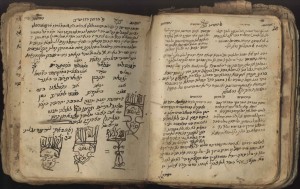Aug
2009
The North African Jewish Collection
With the acquisition of manuscripts from North Africa over the last ten years, the Yale library is becoming a center for the study of North African Jewry. The library’s holdings include manuscripts from Morocco, Algeria, Tunisia and Libya. The heart of the collection, however, is the material relating to the Jews of Morocco. Moroccan Jewry was and still is the largest and most influential in the region. It has a long and illustrious history that goes back to Greco/Roman times and over the centuries the community produced many noted scholars, rabbis, poets, men of commerce, and statesmen. The Jewish population is composed of groups indigenous to the region and Jews that immigrated to Morocco from Spain and Portugal. While Jewish life has ceased to exist in most Muslim countries, Morocco still has an active Jewish community.
The Yale collection contains documents from all the major centers of Jewish life in Morocco. These include Casablanca, Fez, Marrakesh, Mogador (also known as Essaouira), Meknes, Rabat, Sefrou, Tetuan and Tangier. There is also material from smaller and less well-known towns and villages. The documents are in Hebrew, Arabic, Judeo-Arabic, Ladino, French and Spanish. The collection consists of documents from the late 16th to the mid-twentieth centuries. They consist of rabbinic documents concerning such issues as marriage, divorce, property and inheritance. In addition, there are manuscripts of poetry, liturgy and other subjects that remain to be studied and identified. In order to make the North African Collection accessible to researchers, we invited Professor Moshe Bar Asher, who was born in Morocco and is one of the most knowledgeable scholars in the world on the subject, to help organize and catalog the collection. Professor Bar Asher is also president of the National Academy of the Hebrew Language and an emeritus professor of the Hebrew University in Jerusalem. Here are several examples of documents that Professor Bar Asher has identified:
 Ta’anug ve-simhah: This is a unique manuscript of an unknown work whose title is “Ta’anug ve-simhah” by Yehudah ben Avraham El-’Asry from Ksar-Es-Souk, southeastern Morocco (Metaghra, currently known as Tafilalt), copied by his nephew Avraham ben Moshe El-‘Asry in 1916. The manuscript has many colophons, one on the first page and a few others on different pages of the manuscript. All of them indicate the name of the copier and the date. The Manuscript consists of exegesis and novellae on the portion of the week from the Pentateuch and other subjects. The language is mostly Hebrew, however, a few texts are written in the Judeo-Arabic of Ksar-Es-Souk. Rabbi Yehudah was born in the first part of the 19th century and died in 1905. Rabbi Avraham was born in 1902 and died in Jerusalem in 1988.
Ta’anug ve-simhah: This is a unique manuscript of an unknown work whose title is “Ta’anug ve-simhah” by Yehudah ben Avraham El-’Asry from Ksar-Es-Souk, southeastern Morocco (Metaghra, currently known as Tafilalt), copied by his nephew Avraham ben Moshe El-‘Asry in 1916. The manuscript has many colophons, one on the first page and a few others on different pages of the manuscript. All of them indicate the name of the copier and the date. The Manuscript consists of exegesis and novellae on the portion of the week from the Pentateuch and other subjects. The language is mostly Hebrew, however, a few texts are written in the Judeo-Arabic of Ksar-Es-Souk. Rabbi Yehudah was born in the first part of the 19th century and died in 1905. Rabbi Avraham was born in 1902 and died in Jerusalem in 1988.
- A manuscript recording a series of halakhic (legal) decisions by different rabbis of Fez, primarily from the year 1882-1883. Among the rabbis listed are Ya’akov Khalfon, Yosef Samun (d. ca. 1768), Shelomoh Ha-Kohen, and Yuhudah Moshe Aflalo. Many of the decisions are concerned with the collection and distribution of charity for needy Jews living in Fez. More than 125 decisions are included in the collection.
A group of manuscripts bound together and copied in Fez, most probably in the 19th century. The texts were composed, however, in the beginning of the 18th century. They include decisions made by Yehudah ben ‘Attar, Ya’akov ibn Tsur, Yehudah ‘Uzziel, Sa’adia ‘Akiba ben Danan , Shaul ben Danan, and others. Most of these rabbis were the religious leaders of the city of Fez at the end of the 17th and the first part of the 18th century. The scribe is Yitshak Kohen. Many of the texts are queries with detailed answers to various Jewish legal questions (responsa). In addition, one finds in this collection a homily on the subject of establishing fixed times for prayers
These are but a few examples of the manuscripts; there are literally thousands more to be examined. With the assistance of Professor Bar Asher, we hope to get a better understanding of the contents of this important collection.
